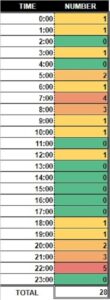BROKEN BOW – Fall tends to find a way to sneak across the state so gracefully it makes the first blooms of spring seem gaudy: the silent agreement between trees to at once shed their green, the tap of a sudden morning chill on the shoulder, football, and twilight’s heyday.
Custer County, square in the midst of Nebraskaland, is prime real estate for Autumners itching to hunker down with a little wool something and a mug none too shy about steaming.
While the county’s upright walkers get to cozying for the season, those on all fours prepare in the opposite way: as the months grow colder and the days shorter, whitetail deer, the predominant species in Custer County and around the state, become more active, foraging for food in the longer, lower light.
Nebraska Game and Parks’ Big Game Disease and Research Program Manager Todd Nordeen explains. “As the season moves on towards the fall, you see more activity; they’re out feeding more, but you also have the mating season, and the bucks in particular are getting more active. Deer get moving around a lot more that time of year.”
The species is crepuscular; its activity peaks in the hours surrounding dusk and dawn. In fact, its eyes are a specific adaptation to lower light levels. They discern hues in the blue-light spectrum with astounding clarity, roughly 20 times better than human perception by some measures; blue light is most widespread during whitetails’ most active hours. For comparison, broad daylight at noon registers as bright white; halogen headlamps tend to register only slightly warmer on the light spectrum.
By human vision standards, deer would be considered legally blind; ongoing research at the University of Georgia’s Deer Research Laboratory suggests a whitetail deer’s vision, if perfect, caps at 20/200. (Perfect human vision, on the other hand, we know to be 20/20.)
The conflict is self-evident. When struck with sudden light, a foraging deer simply goes blind; it freezes. A motor vehicle just moves too quickly to stop before the animal can find its bearings, and by the end of act three, nobody’s happy.
Such collisions are costly to cars and wildlife; they tend to mangle vehicle and ungulate alike. However, while they can be unpredictable, these mishaps are by no stretch unavoidable. Watching one’s proverbial rear end during specific driving hours could help save a dent in the vehicular front end.
Since the start of the New Year, the Custer County Sheriff’s Office reports that nearly one-third of the 90 vehicular collisions in the county have involved deer: 28, to be precise.

The greatest number of those reported collisions happened within the hours of 10:00 p.m. and 7:00 a.m.: 5 between 10 p.m. and 11 p.m., and 4 between 7 a.m. and 8. Not a single reported accident occurred during the brightest times of day, between 1 p.m. and 5 p.m.
Curiously, the Sheriff’s Office recorded zero accidents for the month of April; Nordeen knows why.
“You get into the spring, and a lot of the female deer are having their fawns for the year; they’re more secluded, and you don’t see them actively out there as you do other times of year.”
However, Nordeen says, Custer County residents can expect an uptick in overall deer activity as winter creeps in. “The breeding season tapers off, but they get more into the need for food and searching for shelter.”
As daylight becomes scarce in the upcoming months, Nordeen illuminates several tactics motorists can utilize to keep themselves and mesmerized deer safe.
“It’s helpful, if motorists think in time, to flash their headlights, break up that solid beam; that tends to ‘wake them up’ and get them going. Honking the horn is another thing; that can break that stillness, that staring that they do in the headlights. I’ve done it, and it does work.”
More information about the collision numbers, including a map of approximate collision locations throughout the county, can be found below.






































